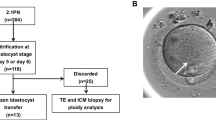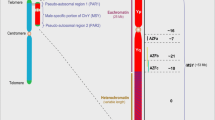Abstract
Trisomy is the leading known cause of mental retardation and pregnancy loss in humans, yet virtually nothing is known of the underlying nondisjunctional mechanisms. Since studies of other organisms suggest an association between centromere size or sequence and meiotic nondisjunction, we recently initiated studies to examine the effect of centromere size variation on human nondisjunction. In the present report, we summarize studies correlating variation in the size of the Y-chromosome centromere with sex chromosome nondisjunction. In one set of studies, we used pulsed-field gel electrophoresis to estimate Y-chromosome alpha-satellite array lengths in normal males, and correlated these values with Y-chromosome sperm disomy levels as determined by fluorescence in situ hybridization. In a second set of studies, we determined the Y-chromosome alpha-satellite array length of 47,XYY males, since the karyotypes of these individuals are a consequence of Y chromosome nondisjunction. Neither set of studies provided evidence for an effect of Y-chromosome alpha-satellite array length on Y-chromosome nondisjunction. Thus, if there is an association between Y-chromosome centromere size and nondisjunction, the effect is subtle and below the detection levels of the present study or involves extreme size variants that were not represented in the present study population.
Similar content being viewed by others
References
Anand R (1986) Pulsed field gel electrophoresis: a technique for fractionating large DNA molecules. Trends Genet 2:278–283
Antonarakis SE (1993) Human chromosome 21: genome mapping and exploration circa 1993. Trends Genet 9:142–148
Cheng YE, Gartler SM (1994) A fluorescence in situ hybridization analysis of X chromosome pairing in early human female meiosis. Hum Genet 94:389–394
Chu G, Volrath D, Davis RW (1986) Separation of large DNA molecules by contour-clamped homogeneous electric fields. Science 234:1582–1585
Griffin D, Abruzzo M, Millie E, Sheean L, Feingold E, Sherman S, Hassold T (1995) Non-disjunction studies of human sperm: evidence for a paternal age effect on trisomy. Hum Mol Genet 4: 2227–2232
Haaf T, Warburton PE, Willard HF (1992) Integration of human alpha-satellite DNA into simian chromosomes: centromere protein binding and disruption of normal chromosome segregation. Cell 70:681–696
Hassold T, Sherman S (1993) The origin of nondisjunction in humans. In: Chandley A, Summer A (eds) Chromosomes today, vol 11. Cambridge University Press, Cambridge, UK, pp 313–322
Hawley RS, Theurkauf WE (1993) Requiem for distributive segregation: achiasmate segregation in Drosophila females. Trends Genet 9: 310–317
Jacobs PA, Hunt PA, Mayer M, Wang JC, Boss GR, Erbe RW (1982) Expression of the marker (X)(q28) in lymphoblastoid cell lines. Am J Hum Genet 34:552–557
Jobling M (1994) A survey of long-range DNA polymorphisms on the human Y chromosome. Hum Mol Genet 3:107–114
Latin Z, Fricker MD, Tyler-Smith C (1994) De novo formation of several features of a centromere following introduction of a Y alphoid YAC into mammalian cells. Hum Mol Genet 3:689–695
Mahtani MM, Willard HF (1990) Pulsed-field gel analysis of alpha-satellite DNA at the human X chromosome centromere: high-frequency polymorphisms and array size estimates. Genomics 7:607–613
Manuelidis L (1976) Repeating restriction fragments of human DNA. Nucleic Acids Res 3:3063–3076
Oakey R, Tyler-Smith C (1990) Y chromosome DNA haplotyping suggests that most European and Asian men are descended from one of two males. Genomics 7:325–330
Robbins W, Segraves R, Pinkel D, Wyrobek A (1993) Detection of aneuploid human sperm by fluorescence in situ hybridization: evidence for a donor difference in frequency of sperm disomic for chromosomes I and Y. Am J Hum Genet 52:799–807
Rosenberg H, Singer M, Rosenberg M (1978) Highly reiterated sequences of SIMIANSIMIANSIMIANSIMIANSIMIAN. Science 200:394–402
Simchen G, Hugerat Y (1993) What determines whether chromosomes segregate reductionally or equationally in meiosis? Bioessays 15:1–8
Spriggs EL, Martin RH (1994) Aneuploidy in 165,330 human sperm: results of two- and three-colour fluorescence in situ hybridization for chromosomes 1, 12, 15, 18, X and Y. Am J Hum Genet 55 [Suppl]: A44
Tyler-Smith C, Oakey RJ, Latin Z, Fisher RB, Crocker M, Affara N, Ferguson-Smith MA, Muenke M, Orsetta Z, Jobling MA (1993) Localization of DNA sequences required for human centromere function through an analysis of rearranged Y chromosomes. Nat Genet 5:368–375
Wevrick P, Willard HF (1989) Long-range organization of tandem arrays of alpha-satellite DNA at the centromeres of human chromosomes: high frequency array-length polymorphism and meiotic stability. Proc Natl Acad Sci USA 86:9394–9398
Willard HF, Waye JS (1987) Hierarchical order in chromosomespecific human alpha-satellite DNA. Trends Genet 3:192–198
Williams BJ, Ballanger CA, Malter HE, Bishop E, Tucker M, Zwingman TA, Hassold TJ (1993) Nondisjunction in human sperm: results of fluorescence in situ hybridization studies using two and three probes. Hum Mol Genet 2:1929–1936
Wyrobek AJ, Robbins WA, Weier HU, Pinkel D (1992) Detection of human sperm carrying sex-chromosomal and autosomal aneuploidies using one, two, and three-color fluorescence in situ hybridizations. Am J Hum Genet 51 [Suppl]: A23
Author information
Authors and Affiliations
Rights and permissions
About this article
Cite this article
Abruzzo, M.A., Griffin, D.K., Millie, E.A. et al. The effect of Y-chromosome alpha-satellite array length on the rate of sex chromosome disomy in human sperm. Hum Genet 97, 819–823 (1996). https://doi.org/10.1007/BF02346196
Received:
Revised:
Issue Date:
DOI: https://doi.org/10.1007/BF02346196




